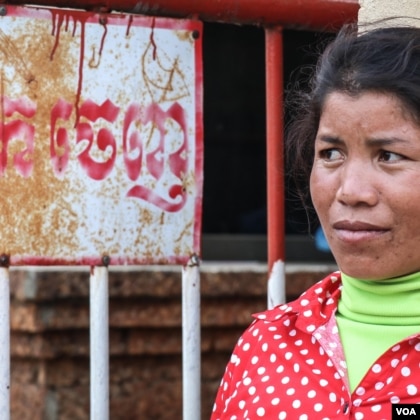
Has Nang, a Cambodian worker headed back to a job in Thailand, waits at a Cambodia-Thai border checkpoint in Battambang province. “If we don’t go to work, we won’t survive,” she said. (Khan Sokummono | VOA Khmer)
Community Stories
‘We Have to Go’
More than 1 million Cambodians have migrated internationally and domestically to find work, a survival strategy that separates families and deprives villages of their young people.
Boeng Reang commune, Battambang Each morning at the bustling, dusty Daung Border Checkpoint in Battambang province, hundreds of Cambodians line up patiently in the slowly rising heat to pass through the Cambodian and Thai immigration offices.
Once they have crossed the border, the mostly young or middle-aged migrant laborers from western Cambodia’s impoverished villages quickly board a bus to one of Thailand’s towns and cities to get to work at plantations, construction sites, food-processing factories or manufacturing plants.
| By the numbers | National |
|---|
Most only make return visits to their home villages and families once or twice per year during the annual Buddhist holidays.
Has Nang, 34, is one of them and like many labor migrants waiting to return to Thailand she appears wearily resigned to her lot.
“There are no jobs in Cambodia. If we don’t go to work we won’t survive, so we have to go,” she said. Has Nang explained that she and her husband began working abroad about two years ago, after consecutive bad harvests at their farm in Battambang’s Trang commune forced them into debt.
A rural exodus
She is among an estimated one million Cambodian migrants who work in Thailand, where wages for unskilled work are several times higher than those paid in Cambodia. About half enter legally like Has Nang, while the rest slip across the border illegally, often with the help of unofficial brokers.
Inside Cambodia, hundreds of thousands of poor villagers also migrate domestically to seek jobs in the thriving garment, tourism and construction sectors in the capital. Phnom Penh.
Both types of migration have continued to increase despite the country’s robust economic growth of recent years, according to researchers. This is because the newly created jobs are only found in urban industries and a lack of rural jobs and indebtedness continue to drive Cambodians out of villages and into cities and across borders.
Two-thirds of all households are indebted to microfinance institutions that charge annual interest rates of 25-40 percent, a 2016 Asia Foundation report estimated. “This has placed tremendous pressure on Cambodian families to repay their loans, and migration has become an alternative income option to do so,” it said.

Has Nang, and her daughter in front of the Cambodia-Thai border checkpoint in Kamrieng district of Battambang province. Nang and her husband have been working at various farms in Thailand for about two years. (Khan Sokummono | VOA Khmer)
Family separation overlooked
After years of admonishment by the International Labor Organisation (ILO) and labor rights groups, Thailand and Cambodia have begun to regulate the massive cross-border flow in order to reduce exploitation and human trafficking of migrants by brokers, employers and corrupt officials.
The share of legal migrants has increased, though reports of abuses remain common and new regulations remain far from comprehensive.
While the need for regulating migration and ending labor abuses has long garnered attention, research on its social impact on migrant families and their home communities has only just begun, Unicef said in a 2017 report (PDF) on the issue.
Has Nang said she and her husband receive a good income at the plantations in Thailand. The working and living conditions are more than acceptable but she is quick to add that their migration has taken its toll on their family. Their 16-year-old daughter dropped out of school to work with her parents, while their 6-year-old-daughter stayed behind with her 60-year-old mother.
“My oldest daughter was not able to regularly going to school because she came with me. But my second daughter is able to study” in the village, Has Nang told VOA Khmer. “I am worried about [their future] but what can I do? We are poor.”

“…Children suffered from a range of negative emotional and psychological impacts due to migration, including the disruption of relationships between parents and children. Most parents in the research visited home only once per year due to the cost of travel.”
Preap Pha surrounded by her eight young children who have been left behind by their parents for Preap Pha to look after. (David Boyle | VOA Khmer)
Psychological impacts
The Unicef research found that like Has Nang, most Cambodian migrants left their children in the village in the care of their aging grandparents, who are often in their sixties, have little or no education, and struggle with the task.
“Most of the grandparents in the study suffered from health problems and described feeling overwhelmed by the burden of taking care of their grandchildren,” said the report, which interviewed 250 caretakers and children. “Many … had been forced to take on the role at this advanced stage in their lives by circumstances beyond their control.”
Unicef said the migration remittances sent by the parents play an important role in greatly improving children’s clothing, food, and education opportunities, while also supporting the remaining family members.
However, the “children suffered from a range of negative emotional and psychological impacts due to migration, including the disruption of relationships between parents and children. Most parents in the research visited home only once per year due to the cost of travel,” the report said.
Unicef warned that children who migrate with their parents—particularly those who drop out of school to do so—are at risk of human trafficking and exploitation.
Government data analyzed by Unicef showed that in Prey Veng, Battambang and Siem Reap provinces, respectively 13 percent, 11 percent and 7 percent of the population had migrated.
The report noted that despite the fact that migration is a widespread social phenomenon, “there are currently no government or international agencies in Cambodia that systematically collect quantitative data on child migrants, or children of adult migrants.”
After raising a family, Preap Pha is raising her grandchildren left behind by their young parents who migrated from rural Cambodia in search of economic opportunity. (David Boyle, Khan Sokummono and Say Mony | VOA Khmer)
‘It is not easy on us’
In Ou Krouch, a village located a few kilometers away from the Daung Border Crossing in Boeng Reang commune, the social costs of labor migration are evident.
There are few villagers aged between 20 and 40 years, and local officials told visiting VOA reporters that some 10 percent of the 17,000-strong commune population had left for nearby Thailand because they faced few job opportunies and rising debts after several bad harvests.
Preap Pha, 61, and her husband, Leap Saroeun, 63, said they have been taking care of eight grandchildren after their three daughters and their husbands went to Thailand in search of work.
“It is not easy on us. It is very tiring and for me, I find myself exhausted at the end of each day. We did not get enough sleep,” Preap Pha said. “It is difficult, but we don’t have any other option,” added Leap Saroeun.
The elderly couple rent out their small plot of land as don’t have the energy or time to farm; they just grow mango saplings, to raise cash.
Their daughters and son-in-laws send back regular, modest remittances— around $30 per week—but these cover the costs of clothing, feeding and schooling of the eight children. ” “We barely have enough money to get by each day,” said Preap Pha. “There are times we did not even have money to buy them some snacks. We could only buy some eggs for them to eat.”
Asked what she thought of migration, she said, “I want to see more development in the community so that there are job opportunities for young people. Then, young parents can stay with their children and there will be less of a burden on grandmothers like me.”









